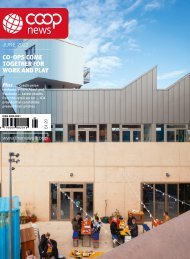FEBRUARY 2018
The February 2018 edition of Co-op News: connecting, challenging and championing the global co-operative movement. This issue looks at the challenges facing workers and co-ops in the context of the future of work. We also interview the International Co-operative Alliance's Ariel Guarco, look at the history of community business and get ready for Fairtrade Fortnight...
The February 2018 edition of Co-op News: connecting, challenging and championing the global co-operative movement. This issue looks at the challenges facing workers and co-ops in the context of the future of work. We also interview the International Co-operative Alliance's Ariel Guarco, look at the history of community business and get ready for Fairtrade Fortnight...
Create successful ePaper yourself
Turn your PDF publications into a flip-book with our unique Google optimized e-Paper software.
competition between certified producers. Balancing<br />
supply with demand is one of the challenges of<br />
the movement, particularly given the time-lag in<br />
preparing producer organisations for certification.<br />
FARMING PERFORMANCE AND THE ENVIRONMENT<br />
There has been limited emphasis on farming<br />
performance and improvement in crop yields<br />
within Fairtrade certification, though it has been<br />
growing over time.<br />
Other certification systems, such as Good<br />
Agricultural Practice (GAP) and UTZ Certified, have<br />
emphasised increased yields, product quality and<br />
attributes as a way to improve producers’ incomes.<br />
Fairtrade has focused more on regulating prices,<br />
trading relationships, strengthening organisations<br />
and governance. Its certification requirements<br />
have not focused on ‘good agricultural practice’ or<br />
specific measures to increase yields or quality.<br />
Indeed, a high proportion of Fairtrade-certified<br />
producers are also certified organic, which is also<br />
likely to influence yields. Evidence has been found<br />
of Fairtrade-certified farmers achieving higher<br />
yields than non-certified farmers, though the<br />
reasons for this were usually hard to disaggregate.<br />
It may be partly due to the strengthening of<br />
organisational structures and services that result<br />
from Fairtrade certification, or from extension<br />
programmes that may be associated with it. It may<br />
also be due to the prior selection of farmers for<br />
certification who were already achieving higher<br />
yields. In some cases, Fairtrade buyers or other<br />
intermediaries may add or incentivise quality<br />
requirements when selecting farmers.<br />
Comparative studies have also shown that other<br />
certification schemes which focus primarily on<br />
‘good agricultural practice’ are more closely<br />
correlated with higher yield production, though<br />
these studies face the same potential problem of<br />
selection bias. Fairtrade objectives are much clearer<br />
for environmental protection. Achievement of<br />
defined standards on such issues as management of<br />
water and soil use, pest control and use of pesticides,<br />
fertiliser application and biodiversity conservation<br />
are included as Fairtrade Standards for both<br />
small producer organisations and plantations.<br />
Research shows positive impacts of certification<br />
and environment-related standards on farming<br />
practices in small producer organisations and<br />
plantations. But given the prevalence of joint<br />
Fairtrade-Organic certification, this may be<br />
due, in part, to the organic certification process.<br />
Other research found that these positive effects<br />
may result from the strength of co-operative<br />
organisation, or from agroecological approaches<br />
promoted by other organisations, rather than from<br />
Fairtrade certification per se.<br />
INVESTMENT OF THE FAIRTRADE PREMIUM<br />
The Fairtrade Premium is set periodically for<br />
each certified commodity and each region. This<br />
is usually a fixed payment per unit of weight, or<br />
as a percentage of the commercial price paid, for<br />
commodities where no minimum price is set. This<br />
is one of the most visible pathways for Fairtrade<br />
<strong>FEBRUARY</strong> <strong>2018</strong> | 37


















